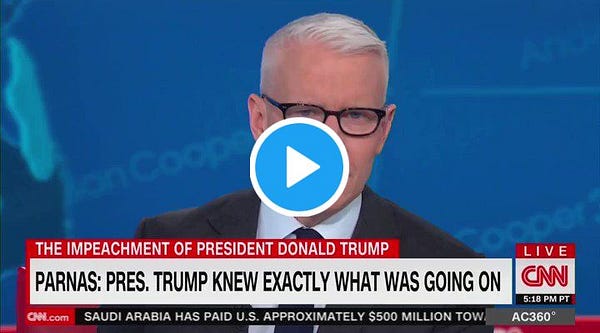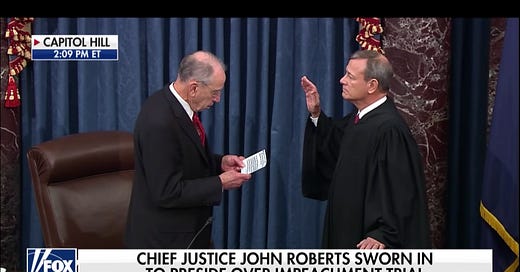FRIDAY EDITION: How does the Senate impeachment trial work?
Plus, the amazing response to yesterday's poll.
Today’s read: 13 minutes.
This is the longest issue of Tangle ever published, but we’re unwrapping some complicated stuff: the Lev Parnas story and how Senate impeachment will work. Tangle usually hits your inbox Monday-Thursday, but today is a special Friday edition of the newsletter. You can expect most editions to be less than a 10-minute read, but there’s a lot to cover today.

Chief Justice John Roberts is sworn in to oversee the impeachment trial by Republican Sen. Chuck Grassley. Screenshot: Fox News.
What D.C. is talking about.
Lev Parnas and impeachment. Just as the Senate begins its trial (more on that below), House Democrats released a new trove of evidence related to the Donald Trump-Ukraine scandal. Included in that evidence were text messages, handwritten notes, voicemails and documents turned over by Lev Parnas. Parnas is a Florida-based, Soviet-born businessman, who was an associate of Rudy Giuliani’s, the president’s personal lawyer (stick with me). Central to the impeachment question is what role the president had in an apparent campaign to pressure Ukraine’s top officials and president into opening an investigation into Joe Biden. Based on interviews Parnas did with MSNBC, CNN, The New York Times, and the evidence he turned over — Trump’s role was prominent. Parnas was arrested in October with his business associate Igor Fruman. The two were caught at a D.C. airport with one-way tickets out of the country and were charged with a series of campaign finance violations that amounted to a “complex web of financial and political interactions linking diplomacy to alleged violations of campaign finance law,” as The Washington Post put it. Together, Parnas and Fruman were soliciting donations to Trump and Republicans, working with Giuliani on a security business, and had been dispatched to Ukraine to help dig up dirt on Joe Biden and his son Hunter. After they were arrested, Parnas and Fruman had an apparent split. Parnas fired his lawyer, another personal attorney of the president’s, and after hiring new counsel and while being investigated by the FBI announced publicly that he’d be willing to testify against the president.
What the left is saying.
It’s almost comical how corrupt this whole thing is. Parnas provided text messages that clearly demonstrate the president’s role in a scheme to pressure Ukraine into investigating the Bidens. Parnas, Fruman and Giuliani were all trying to get Marie Yovanovitch, the U.S. ambassador to Ukraine, fired. They hated her because they did not believe she sufficiently supported Trump’s agenda in Ukraine. They also saw her as a roadblock who would stunt their effort to press Ukrainian officials into announcing an investigation into Joe Biden. In one text from Giuliani referring to Yovanovitch, he says there are “concerns” from “up the street” (an apparent reference to the White House) about Yovanovitch. In another, Parnas is communicating with Robert F. Hyde, a man currently running for Congress as a Republican. Hyde texts Parnas: “Wow. Can’t believe Trumo [sic] hasn’t fired this bitch. I’ll get right in that.” He then sends Parnas several text messages that seem to suggest he had Yovanovitch under surveillance while she was working as a diplomat in Ukraine. “They are willing to help if we/you would like a price,” Hyde says to Parnas. Democrats have seized on these messages in particular because, during her testimony in the House impeachment probe, Yovanovitch said that she was hastily removed from her post in Ukraine and got the impression that she may have been in some kind of danger.
Parnas also turned over a screenshot of a letter that Giuliani had drafted to Ukraine’s President Volodymyr Zelensky. In the letter, Giuliani requests a meeting with Zelensky, and states unequivocally that he is acting with President Trump’s “knowledge and consent.” The letter had not been previously disclosed. But Giuliani had spoken about that meeting, which he described publicly as an attempt to “meddle in an investigation” in Ukraine, presumably the dormant investigation into Joe Biden’s son. All of this, together, adds to the evidence that Giuliani and Parnas were working at the direction of Trump to do exactly what he’s being charged with during the impeachment inquiry.


What the right is saying.
President Trump is saying he doesn’t even know Parnas. “I don’t know him at all. Don’t know what he’s about. Don’t know where he comes from. Know nothing about him.” A few months ago, he said: “It’s possible I have a picture with them because I have a picture with everybody.” (Parnas’s team has released several photos and videos of him with President Trump as an attempt to prove they are well-acquainted). The White House dismissed Parnas’s claims and evidence as a desperate attempt from someone under FBI investigation to lessen their sentence. There are also serious questions about Parnas’s credibility. In November, CNN reported that Parnas had direct conversations with President Trump in which he was sent on a “James Bond mission” related to Ukraine and was instructed to dig up dirt on Joe Biden. Those accounts were reported out based on what Parnas had told friends and associates. But during his round of interviews this week, Parnas never claims to speak directly to the president. He instead says he knew the president was in the loop because Giuliani would answer phone calls from Trump and discuss the issue while on speakerphone.
Then there’s the question of what Parnas was doing before Giuliani got in touch with him. Federal prosecutors indicted Parnas for claims that he was trying to oust Yovanovitch “at the request of one or more Ukrainian government officials.” The New York Times reported that Parnas was the one who initially told Trump that Yovanovitch was bad-mouthing him in Ukraine, and he helped set off Trump’s desire to fire Yovanovitch. Since Parnas is charged with working for Ukrainian officials to oust Yovanovitch before he was working for Trump and Giuliani, conservatives have noted that evidence undercuts Democrats’ claims that Trump and Giuliani recruited Parnas to remove Yovanovitch. In fact, they say, the opposite could be true: perhaps Parnas was using Giuliani and Trump for a common goal. Parnas also denied any claims that he and Hyde were surveilling Yovanovitch. Instead, he described Hyde as being constantly drunk and said the texts were just two friends making jokes, which is the same excuse Hyde used in a tweet about the allegations.





My take.
I don’t trust Parnas at all and I think Democrats would be well-served to ignore basically anything he says on camera. There’s been enough reporting on this guy to understand that he is a slimy, corrupt, well-connected politico who clearly had at least a half dozen schemes cooked up with D.C. insiders to help advance his own interests. He contradicts himself regularly. He embellishes, brags and makes bold claims. And his story has changed repeatedly. When I watched Parnas on CNN and MSNBC, all I could think was how comfortable he looked on camera. I’ve been in that seat and I can tell you it is incredibly nerve-racking when you’re up there just spouting your own punditry. This guy was making criminal allegations against the president and he looked cool as a cucumber. In its own paradoxical way, that made me trust him less.
Now, all that being said: I do trust hard evidence. And Parnas has provided a lot of that. The letters, the texts, the voicemails, they all reveal fine details of what was clearly an effort from people in Trump’s orbit to dig up dirt on Joe Biden in Ukraine. Trump’s claims that he doesn’t know Parnas are also absurd and laughable. The photos Parnas released together don’t prove much — I have photos of me standing beside famous people I don’t know — but there are dozens of reports about the interactions between POTUS and Parnas. Parnas has also been going to Mar-a-Lago as far back as 2016. And Trump has a long, well-documented history of claiming he “doesn’t know” people he knows perfectly well. So am I buying Trump’s claims that he doesn’t know him? Definitely not.
Finally, the scheme: Parnas’s role here is critical. He was traveling to Ukraine, he was the one spreading rumors that Yovanovitch was bad-mouthing the president, he may have even been surveilling a U.S. diplomat and he absolutely was working with Giuliani to find dirt on Biden. He said he did all of this because he believed in Trump and thought he would be one of the greatest presidents of all-time. Now he’s changed his tune when he got the feeling Trump was turning on him. I’d really like to see Parnas testify under oath, but I’m not sure it’s going to happen. It’s worth noting, too, that I don’t think “Parnas was working for Trump” and “Parnas was working for Ukrainian officials” are mutually exclusive. He very well could have been working for Ukrainian officials to oust Yovanovitch, as prosecutors have alleged, and have been working with Trump to dig up dirt on Biden and secure Yovanovitch’s firing.
I’ve written about how the scheme Giuliani and Trump cooked up was actually rather simple, and I have definitely landed in a place where I believe Trump was pressuring Zelensky and Ukraine into investigating the Bidens. I’ll also add that, in a nerdy way, the biggest thing that happened for me this week was the Government Accountability Office (GAO) declaring that it was illegal for the Trump administration to hold Ukraine’s military aide. That is a pretty damning stance for a non-partisan organization to take and it should get more attention.
Your questions, answered.
Reminder: you can ask a question too. All you have to do to get a hold of me is simply reply to this email or tweet at Tangle News.
I’ve gotten a ton of questions about the impeachment trial in the Senate, how it works and what to expect. People wrote in from Seattle, Iowa, Philadephia, Kansas and Connecticut asking about it. So I am going to answer all those questions with a simplified breakdown of what’s going on.
First, an introduction: The Senate is where the “trial” of impeachment happens. The founders drew up this process to function in two stages: the House of Representatives, the lower chamber of Congress, gathers evidence and debates it. If they vote and decide to impeach a president, that evidence and the articles of impeachment are then transmitted to the Senate, the upper chamber. That part is complete and already happened.
The Senate is the body of Congress that decides whether to remove the president. They make that decision by listening to “House managers,” or carefully selected members of the House, who present the evidence it found during its inquiry. Democrats chose their House managers already, and Trump is slowly announcing his defense team as we speak (controversially, it already includes Ken Starr — who prosecuted Bill Clinton during his impeachment, and Alan Dershowitz — a Fox News commentator who represents the deceased accused pedophile Jeffrey Epstein). After hearing the evidence, asking questions and perhaps presenting witnesses, they vote. If two-thirds of the Senate, or 67 senators, vote to remove Trump, he will be forced out of office. Today’s Senate is made up of 53 Republicans, 45 Democrats and 2 independents (both independents “caucus,” or vote, with Democrats). Essentially, it’s 53 Republicans and 47 Democrats. Assuming all Democrats and Independents vote to remove Trump (47 votes), there would need to be 20 Republicans to jump ship in order to remove him from office. That outcome is extremely unlikely.
Old school. Because this is only the third Senate trial in American history, and because this process was created so long ago, there are some very traditional and archaic rules. The procedures feel straight out of the 18th century. It’s actually kind of cool. For instance, House Democrats had to walk a hard copy of the articles of impeachment through the Capitol Building rotunda and to the Senate chamber. When they arrived, the Sergeant-at-arms (the head officer of the House who has law enforcement duties to protect members of Congress), shouted out “Hear ye! Hear ye!” and warned members of the Senate that they had to remain quiet “on pain of imprisonment.” In other words, members of the Senate were warned they’d be thrown in jail if they spoke while the articles of impeachment were being read.
This kind of old school theme will be present throughout the Senate trial. In fact, senators will have to sit quietly, without electronics, while the House managers make their case. They can only ask questions by writing them down and submitting them. They can only object to a motion in the Senate by a formal procedure in which the press would be kicked out of the Senate chamber and the senators would debate the motion privately. They have to remain seated during the entire thing. It’s all very, very old school — and totally unlike any other modern hearing in Congress.
Chief Justice Roberts. Speaking of old school, the entire impeachment trial will be overseen by Chief Justice John Roberts, who is “head” of the Supreme Court. Typically, when there is a tie on a vote in the Senate, the Vice President gets the tiebreaking vote. But because this issue involves the president’s office, Roberts is appointed to oversee the entire thing. He settles disputes. He gets the final say when an agreement can’t be made. Roberts is considered a “conservative” justice, though he has sometimes been called a disappointment by Republicans who supported his appointment to the Supreme Court (his votes aren’t as predictable as they’d hoped).
The read on Roberts is that he’d rather do anything but this. Impeachment is a dramatic, partisan affair and Roberts has largely avoided all of that while in the Supreme Court. This gives the country an opportunity to frame him as being on one side or the other, something he’s very reluctant about. During Bill Clinton’s impeachment trial, Chief Justice William Rehnquist was largely hands-off. Rehnquist once joked that he "did nothing in particular and did it very well.” It’s expected that Roberts will do his best to emulate that.
What’s next. The trial will begin in earnest on Tuesday, January 21st. That’s when senators will begin voting on procedural issues not dictated in the constitution, which is pretty much everything. That means the Republican-led Senate can decide how the trial goes down. Those procedures can be passed with 51 votes, which means the 53-person majority the Republicans have will give them wide latitude to set a lot of ground rules. Mitch McConnell, the Majority Leader of the Senate, says he has the votes to set up the procedures he wants. But he hasn’t released the text of his proposed rules, so everyone is in the dark on what’s going to happen. They’re expected to be revealed early next week, and the Senate could vote as early as Tuesday on what rules to move forward with. Again: the members of the Senate will sit and observe as House managers and Trump’s defense team present their cases, only able to submit written questions. Aside from that, and Roberts presiding over any disputes, there are very few rules governing how this goes down.
What people are watching. Remember that guy Lev Parnas we talked about at the top? He’s just one person, and his evidence is just one set of documents, that Democrats would like to bring forward. But part of what Republicans control is what witnesses and what evidence makes its way to the Senate trial. Republicans are arguing that it’s the House’s job to provide witnesses and evidence, so they aren’t going to add any witnesses or evidence that wasn’t presented in the House impeachment phase. A lot of people expect Republicans to write and pass rules that say no witnesses will be called forward, which would be a huge win for Trump. Everyone has their eyes on more moderate Republicans. Three senators — Susan Collins, Lamar Alexander, and Mitt Romney — have already indicated they wanted to hear from witnesses. If that’s true, and all the Democrats hold their ground, then McConnell will be forced to allow witnesses. But there are repercussions for that, too: if witnesses are greenlit, Republicans have threatened to call forward Joe Biden or Hunter Biden, or other Democrats, who they say have a crucial role in the “sham” impeachment process (a central Republican argument is that Trump was earnestly looking into corruption in Ukraine that the Bidens were involved in, so calling them as witnesses is fair game.)
Democrats have indicated they want to call forward former and current members of the administration like John Bolton (former national security adviser) and Mick Mulvaney (current chief of staff). The battle over witnesses is expected to be one of the most contentious parts of this whole thing. While a vote to acquit Trump seems inevitable, if several witnesses come forward and present damaging testimony it could pull over a few moderate Republicans or simply move public opinion against Trump on the impeachment scandal.
Finally, there’s a real possibility the Senate moves quickly to a vote and dismisses the charges against Trump without anything that resembles a trial. It only takes 51 Senate votes to dismiss the charges, and it’s possible McConnell could whip all but two Republicans into the move. It’d be extremely controversial but it hasn’t been ruled out. We’ll know a lot more on Tuesday night.
P.S. 99 senators stood, right hands raised and were sworn in for the Senate trial on Thursday. Roberts asked them, "Do you solemnly swear that in all things appertaining to the trial of the impeachment of Donald John Trump, president of the United States, now pending, you will do impartial justice according to the Constitution and laws, so help you god?" Then senators came forward and swore an “oath book” one by one. The only senator not present was James Inhofe (R-Oklahoma), who was home with a family member facing a medical issue. His staff said he’d be sworn in on Tuesday.
A story that matters.
The Wall Street Journal is reporting that nearly a dozen U.S. troops are being screened for “traumatic brain injuries” after the missile strikes Iran conducted against two military bases in Iraq where U.S. forces were housed. This disclosure, made late Thursday night by U.S. Central Command, is pretty interesting. Administration officials and the Pentagon initially updated Americans on the attacks by saying there were “no casualties” and limited damage done to the bases. But check out the photo, from January 13th, The WSJ published alongside its headline. Does it look like small amounts of damage?

Screenshot: The Wall Street Journal
According to The WSJ, the U.S. Central Command “acknowledged that there were injuries and the 11 service members suffered concussions during the attack.” But still: if U.S. soldiers suffered concussions or traumatic brain injuries from the rocket attacks, it seems safe to presume they were pretty close to the attacks. The attacks took place on January 8th in response to the killing of Gen. Soleimani. It’s now January 17th and we’re only just learning about the injuries. This is precisely why I told Tangle readers not to “call balls and strikes or wins and losses” on the outcome of the strike against Soleimani until a few months from now, when we had more information. It’s also why you should remain skeptical about the government’s telling of events until reporters and additional information can contextualize it. You can read the WSJ story here.
The New York Times.
On Sunday, the New York Times editorial board is going to endorse a Democratic candidate for president. Their pick is highly influential and a much-speculated upon choice. This year, they are being very transparent about their process and releasing videos and full transcripts of their interviews with candidates to make their choice. A few notable moments have come up so far. First was a very confrontational interview with Pete Buttigieg, that you can read here. Another was this moment with Andrew Yang, where he is asked about a recent heartbreak and he says Barack Obama hurt him:


By the way.
Yesterday, the New York Times scooped a report that federal prosecutors are probing whether former FBI Director James Comey leaked classified documents to reporters. In an interesting twist, the leaks related to documents Comey allegedly turned over to… The New York Times and The Washington Post. It’s an unusual inquiry as most leak investigations take place right after the leaks happen. This one is about a leak from a few years ago, though, which has raised speculation it’s a political hit on Comey from folks in the Trump administration who view him as an enemy. Click.
Numbers.
52%. The disapproval rating for Maine Republican Susan Collins, making her the most disliked senator in America.
$32 billion. The amount of money America’s six biggest banks saved after Trump’s 2017 tax cuts, according to Bloomberg.
8. The number of senators who voted against Trump’s USMCA trade agreement.
17%. The percentage of Americans who considered themselves liberal in 1992, according to Gallup.
26%. The percentage of Americans who considered themselves liberal in 2018, according to Gallup.
44-52. Trump’s approval-disapproval rating in Wisconsin according to a Marquette Law poll from January of last year.
48-49. Trump’s approval-disapproval in Wisconsin according to a Marquette Law poll from this January.
8 in 10. The number of black Americans who view Trump as “racist,” according to a Washington Post-Ipsos poll released this week.
1. The number of Tangle readers who answered yesterday’s poll and said they were 13-17 years old. Here’s the full breakdown:

Have a nice day.
Researchers say a new vaccine to prevent dementia could be two years away from human trials. The researchers had successful tests on mice and published the study in Alzheimer’s Research & Therapy journal. The treatment is a combination of two drugs that remove “brain plaque” and a protein in the brain linked to cognitive decline. While it’s unlikely to be available to the public anytime soon, the research points to a real possibility that an Alzehimer’s vaccine could become available in our lifetime. 5.7 million people are currently living with the disease in the United States alone. Click.
Don’t forget.
Tangle only grows with your help. Since it’s free now, the best way to support the newsletter is to forward it to friends or post about it on social media. If someone forwarded you this email, you can subscribe by entering your email address below:



